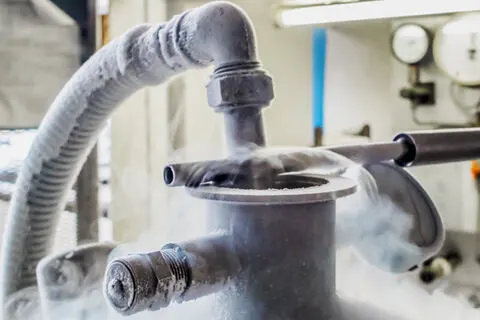Steel and Other Components

Steel and other Components provides standards that give specifications for metals that can be used in cryogenic conditions or application.
ASTM A1106/A1106M-17
Standard Specification for Pressure Vessel Plate, Alloy Steel, Austenitic High Manganese for Cryogenic Application
1.1 This specification2 covers austenitic high-manganese alloy steel plates produced by hot rolling and controlled cooling. The plates are intended primarily for use in welded pressure vessels.
1.2 Due to the inherent characteristics of the rolling and cooling processes, or both, the plates shall not be formed at temperatures exceeding 932°F [500°C].
1.3 The maximum thickness of plates is limited only by the capacity of the material to meet the specified mechanical property requirements; however, current mill practice normally limits this material to 2.5 in. [63.5 mm] max.
1.4 The values stated in either inch-pound units or SI units are to be regarded separately as standard. Within the text, the SI units are shown in brackets. The values stated in each system are not exact equivalents; therefore, each system must be used independently of the other. Combining values from the two systems may result in nonconformance with the specification.
1.5 This standard does not purport to address all of the safety concerns, if any, associated with its use. It is the responsibility of the user of this standard to establish appropriate safety and health practices and determine the applicability of regulatory limitations prior to use.
ANSI/MSS SP-134-2012
Valves for Cryogenic Service, including Requirements for Body/Bonnet Extensions
This Standard Practice covers requirements for material, design, dimensions, fabrication, non-destructive examination and pressure testing of stainless steel and other alloy cryogenic service valves with body/bonnet extensions. Requirements for check valves for cryogenic service, which may not require body/bonnet extensions, are also covered.
ASTM A962/A962M-19
Standard Specification for Common Requirements for Bolting Intended for Use at Any Temperature from Cryogenic to the Creep Range
1.1 This specification covers a group of common requirements that shall apply to carbon, alloy, stainless steel, and nickel alloy bolting under any of the following ASTM Specifications (or under any other ASTM Specifications that invoke this specification or portions thereof): 1.2 In case of conflict, the requirements of the individual product specification shall prevail over those of this specification. 1.3 Fasteners are a wide-ranging classification that includes screws, bolts, nuts, washers, stud bolts, rivets, powder-actuated studs, staples, tacks, and pins. Bolting, which is composed of bolting materials, such as rods, bars, flats, and forgings, which are subsequently manufactured into bolting components, are a special sub-group of fasteners. Bolting materials and components have designated compositions and specific properties intended for applications in aggressive service where commercial generic fasteners may not be suitable or have insufficient fitness for purpose under certain conditions. These conditions include cryogenic or high temperature service, or excessive vibration, impact, or shock. To further address any other special service conditions where bolting is intended for use, additional requirements may be specified by mutual agreement between the purchaser and supplier. 1.4 Supplementary requirements are provided for use at the option of the purchaser. The supplementary requirements only apply when specified individually by the purchaser in the purchase order or contract. 1.5 This specification is expressed in both inch-pound units and in SI units. Unless the purchase order or contract specifies the applicable M specification designation (SI units) the inch-pound units shall apply. The values stated in either SI units or inch-pound units are to be regarded separately as standard. Within the text, the SI units are shown in brackets. The values stated in each system may not be exact equivalents; therefore, each system shall be used independently of the other. Combining values from the two systems may result in nonconformance with the specification. 1.6 This international standard was developed in accordance with internationally recognized principles on standardization established in the Decision on Principles for the Development of International Standards, Guides and Recommendations issued by the World Trade Organization Technical Barriers to Trade (TBT) Committee.





